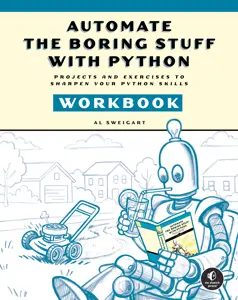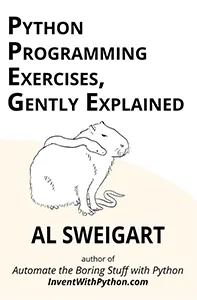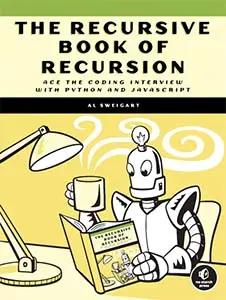








In this classic tile-dropping board game for two players, you must try to get four of your tiles in a row horizontally, vertically, or diagonally, while preventing your opponent from doing the same. This program is similar to Connect Four.
When you run fourinarow.py, the output will look like this:
Four in a Row, by Al Sweigart [email protected]
--snip--
1234567
+-------+
|.......|
|.......|
|.......|
|.......|
|.......|
|.......|
+-------+
Player X, enter a column or QUIT:
> 3
1234567
+-------+
|.......|
|.......|
|.......|
|.......|
|.......|
|..X....|
+-------+
Player O, enter a column or QUIT:
> 5
--snip--
Player O, enter a column or QUIT:
> 4
1234567
+-------+
|.......|
|.......|
|XXX.XO.|
|OOOOXO.|
|OOOXOX.|
|OXXXOXX|
+-------+
Player O has won!The board game projects in this book follow a similar program structure. There’s often a dictionary or list for representing the state of the board, a getNewBoard() function that returns a data structure for a board, a displayBoard() function for rendering a board data structure on the screen, and so on. You can check out the other projects in this book with the board game tag and compare them with each other, especially when you want to create your own original board game programs.
1. """Four in a Row, by Al Sweigart [email protected]
2. A tile-dropping game to get four in a row, similar to Connect Four.
3. View this code at https://nostarch.com/big-book-small-python-projects
4. Tags: large, game, board game, two-player"""
5.
6. import sys
7.
8. # Constants used for displaying the board:
9. EMPTY_SPACE = '.' # A period is easier to count than a space.
10. PLAYER_X = 'X'
11. PLAYER_O = 'O'
12.
13. # Note: Update displayBoard() & COLUMN_LABELS if BOARD_WIDTH is changed.
14. BOARD_WIDTH = 7
15. BOARD_HEIGHT = 6
16. COLUMN_LABELS = ('1', '2', '3', '4', '5', '6', '7')
17. assert len(COLUMN_LABELS) == BOARD_WIDTH
18.
19.
20. def main():
21. print("""Four in a Row, by Al Sweigart [email protected]
22.
23. Two players take turns dropping tiles into one of seven columns, trying
24. to make four in a row horizontally, vertically, or diagonally.
25. """)
26.
27. # Set up a new game:
28. gameBoard = getNewBoard()
29. playerTurn = PLAYER_X
30.
31. while True: # Run a player's turn.
32. # Display the board and get player's move:
33. displayBoard(gameBoard)
34. playerMove = askForPlayerMove(playerTurn, gameBoard)
35. gameBoard[playerMove] = playerTurn
36.
37. # Check for a win or tie:
38. if isWinner(playerTurn, gameBoard):
39. displayBoard(gameBoard) # Display the board one last time.
40. print('Player ' + playerTurn + ' has won!')
41. sys.exit()
42. elif isFull(gameBoard):
43. displayBoard(gameBoard) # Display the board one last time.
44. print('There is a tie!')
45. sys.exit()
46.
47. # Switch turns to other player:
48. if playerTurn == PLAYER_X:
49. playerTurn = PLAYER_O
50. elif playerTurn == PLAYER_O:
51. playerTurn = PLAYER_X
52.
53.
54. def getNewBoard():
55. """Returns a dictionary that represents a Four in a Row board.
56.
57. The keys are (columnIndex, rowIndex) tuples of two integers, and the
58. values are one of the 'X', 'O' or '.' (empty space) strings."""
59. board = {}
60. for columnIndex in range(BOARD_WIDTH):
61. for rowIndex in range(BOARD_HEIGHT):
62. board[(columnIndex, rowIndex)] = EMPTY_SPACE
63. return board
64.
65.
66. def displayBoard(board):
67. """Display the board and its tiles on the screen."""
68.
69. '''Prepare a list to pass to the format() string method for the
70. board template. The list holds all of the board's tiles (and empty
71. spaces) going left to right, top to bottom:'''
72. tileChars = []
73. for rowIndex in range(BOARD_HEIGHT):
74. for columnIndex in range(BOARD_WIDTH):
75. tileChars.append(board[(columnIndex, rowIndex)])
76.
77. # Display the board:
78. print("""
79. 1234567
80. +-------+
81. |{}{}{}{}{}{}{}|
82. |{}{}{}{}{}{}{}|
83. |{}{}{}{}{}{}{}|
84. |{}{}{}{}{}{}{}|
85. |{}{}{}{}{}{}{}|
86. |{}{}{}{}{}{}{}|
87. +-------+""".format(*tileChars))
88.
89.
90. def askForPlayerMove(playerTile, board):
91. """Let a player select a column on the board to drop a tile into.
92.
93. Returns a tuple of the (column, row) that the tile falls into."""
94. while True: # Keep asking player until they enter a valid move.
95. print('Player {}, enter a column or QUIT:'.format(playerTile))
96. response = input('> ').upper().strip()
97.
98. if response == 'QUIT':
99. print('Thanks for playing!')
100. sys.exit()
101.
102. if response not in COLUMN_LABELS:
103. print('Enter a number from 1 to {}.'.format(BOARD_WIDTH))
104. continue # Ask player again for their move.
105.
106. columnIndex = int(response) - 1 # -1 for 0-based the index.
107.
108. # If the column is full, ask for a move again:
109. if board[(columnIndex, 0)] != EMPTY_SPACE:
110. print('That column is full, select another one.')
111. continue # Ask player again for their move.
112.
113. # Starting from the bottom, find the first empty space.
114. for rowIndex in range(BOARD_HEIGHT - 1, -1, -1):
115. if board[(columnIndex, rowIndex)] == EMPTY_SPACE:
116. return (columnIndex, rowIndex)
117.
118.
119. def isFull(board):
120. """Returns True if the `board` has no empty spaces, otherwise
121. returns False."""
122. for rowIndex in range(BOARD_HEIGHT):
123. for columnIndex in range(BOARD_WIDTH):
124. if board[(columnIndex, rowIndex)] == EMPTY_SPACE:
125. return False # Found an empty space, so return False.
126. return True # All spaces are full.
127.
128.
129. def isWinner(playerTile, board):
130. """Returns True if `playerTile` has four tiles in a row on `board`,
131. otherwise returns False."""
132.
133. # Go through the entire board, checking for four-in-a-row:
134. for columnIndex in range(BOARD_WIDTH - 3):
135. for rowIndex in range(BOARD_HEIGHT):
136. # Check for horizontal four-in-a-row going right:
137. tile1 = board[(columnIndex, rowIndex)]
138. tile2 = board[(columnIndex + 1, rowIndex)]
139. tile3 = board[(columnIndex + 2, rowIndex)]
140. tile4 = board[(columnIndex + 3, rowIndex)]
141. if tile1 == tile2 == tile3 == tile4 == playerTile:
142. return True
143.
144. for columnIndex in range(BOARD_WIDTH):
145. for rowIndex in range(BOARD_HEIGHT - 3):
146. # Check for vertical four-in-a-row going down:
147. tile1 = board[(columnIndex, rowIndex)]
148. tile2 = board[(columnIndex, rowIndex + 1)]
149. tile3 = board[(columnIndex, rowIndex + 2)]
150. tile4 = board[(columnIndex, rowIndex + 3)]
151. if tile1 == tile2 == tile3 == tile4 == playerTile:
152. return True
153.
154. for columnIndex in range(BOARD_WIDTH - 3):
155. for rowIndex in range(BOARD_HEIGHT - 3):
156. # Check for four-in-a-row going right-down diagonal:
157. tile1 = board[(columnIndex, rowIndex)]
158. tile2 = board[(columnIndex + 1, rowIndex + 1)]
159. tile3 = board[(columnIndex + 2, rowIndex + 2)]
160. tile4 = board[(columnIndex + 3, rowIndex + 3)]
161. if tile1 == tile2 == tile3 == tile4 == playerTile:
162. return True
163.
164. # Check for four-in-a-row going left-down diagonal:
165. tile1 = board[(columnIndex + 3, rowIndex)]
166. tile2 = board[(columnIndex + 2, rowIndex + 1)]
167. tile3 = board[(columnIndex + 1, rowIndex + 2)]
168. tile4 = board[(columnIndex, rowIndex + 3)]
169. if tile1 == tile2 == tile3 == tile4 == playerTile:
170. return True
171. return False
172.
173.
174. # If the program is run (instead of imported), run the game:
175. if __name__ == '__main__':
176. main()After entering the source code and running it a few times, try making experimental changes to it. The comments marked with (!) have suggestions for small changes you can make. On your own, you can also try to figure out how to do the following:
Try to find the answers to the following questions. Experiment with some modifications to the code and rerun the program to see what effect the changes have.
PLAYER_O = 'O' on line 11 to PLAYER_O = 'X'?return (columnIndex, rowIndex) on line 116 to return (columnIndex, 0)?response == 'QUIT' on line 98 to response != 'QUIT'?tileChars = [] on line 72 to tileChars = {}?